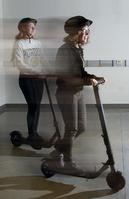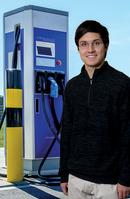Undergrads energize transportation research
At the Lyles School, undergraduates thrive in the Traffic Lab
When entering the cozy Traffic Lab in Purdue's Hampton Hall of Civil Engineering, you're met by a life-size traffic light hanging from the ceiling. (Yes, it’s functioning!) Road signs and street signs line the walls. Students are manipulating colorful shapes and graphs on computer screens.
Officially called the Harold L. Michael Traffic Operations Laboratory, the facility is a hub for transportation research at Purdue University. Darcy Bullock, Lyles Family Professor of Civil Engineering, leads the lab and directs the Joint Transportation Research Program.
Analyzing traffic patterns
The lab performs vital traffic engineering research for a variety of sponsors, including the National Cooperative Research Program, several state departments of transportation and the Federal Aviation Administration. One focus of undergraduate research over the past few years has been the analysis of vehicle data to monitor Indiana interstate congestion that is due to traffic growth, work zones and inclement weather.
During the summer months, transportation agencies provide a list of interstate construction projects they want to monitor. Civil engineering senior Cassie McKee, in her second year at the lab, creates weekly reports for the Indiana Department of Transportation on traffic patterns around those work zones. Her analyses help INDOT identify unanticipated congestion and to pinpoint and mitigate work-zone congestion and queuing.
"I take speed and position data for highway vehicles, and I use that with our visualization tools to get an idea of what's happening in the work zones," McKee explains. "I also look at the crash database to determine if crashes are causing congestion, or if crashes are associated with queued traffic upstream of the work zone."
Students perform similar analyses on how inclement weather affects interstate traffic. Using the lab's computer-visualization tools, students generate winter-weather traffic reports for INDOT to monitor the efficiency of their winter operation activities.
McKee and fellow undergrad Meg Hunter are recipients of the Jack V. Skillman Award, which enabled them to attend the 2019 Transportation Research Board meeting in Washington, D.C. "They even had a chance to ride in an autonomous vehicle on their trip," Bullock says.
Undergraduates also perform research out in the field. Senior Alek Venturino has been studying the efficiency of Purdue's electric vehicle charging stations. For one project, he visited each of the eight charging stations on campus, twice a day. Venturino recorded data such as occupancy and plugins. He took geotagged photos and noted whether or not the vehicle was authorized to park in the spot.
"Working with Professor Bullock on this project has been fascinating," Venturino says. "When I am working as a civil engineer in transportation, this sort of experience will come into play for companies considering upgrades to things such as parking lots, rest areas, service stations, you name it."
In another effort, Bullock's team is working on next-generation cars that interact with traffic signals to improve the vehicle efficiency and engine control. The research employs an Audi sedan tricked out with a real-time interface to traffic signals on U.S. Highway 231, adjacent to campus. Undergraduate Bill Morgan was part of the team that looked at the performance of a 10-intersection deployment of the system, in which the signals communicated with the Audi as it traveled. That system will be deployed at 30 additional intersections in the West Lafayette area later in 2019.
High-profile partnership
In 2017, Ford Motor Company and Purdue formed a research-and-development alliance for developing an array of technologies for automobiles — and more broadly for mobility solutions and transportation services.
One high-profile Purdue-Ford project explores best practices for e-scooters. Led by Bullock, the effort is thought to be the first academic research to examine how the oft-maligned e-scooters can best be incorporated into an urban environment.
In late 2018, 40 of Ford's "Jelly" brand scooters were distributed across Purdue's campus. The Traffic Lab's Cassie McKee, who uses a longboard or a bike to get around campus, provided student input for the study and was part of the team gathering data on the scooter usage.
"Students love scooters because they solve the 'last mile' problem," McKee says. "You get close to your destination, say a parking garage, but you still have that last mile on campus." On the other hand, students tend to leave the scooters lying in walkways and ride them on sidewalks, making for accessibility and safety problems.
"That's my main concern with them. The responsible use and storage of scooters. We want to make sure people use them safely," McKee adds.
"Scooters are a new transportation mode that we have no design guidelines for, and agencies are looking for guidance," Bullock says. "In the city of Indianapolis alone, over 475,000 miles were driven on by 8,000 scooters from September to November 2018. It is important to understand how these vehicles are used and how to safely integrate them."


